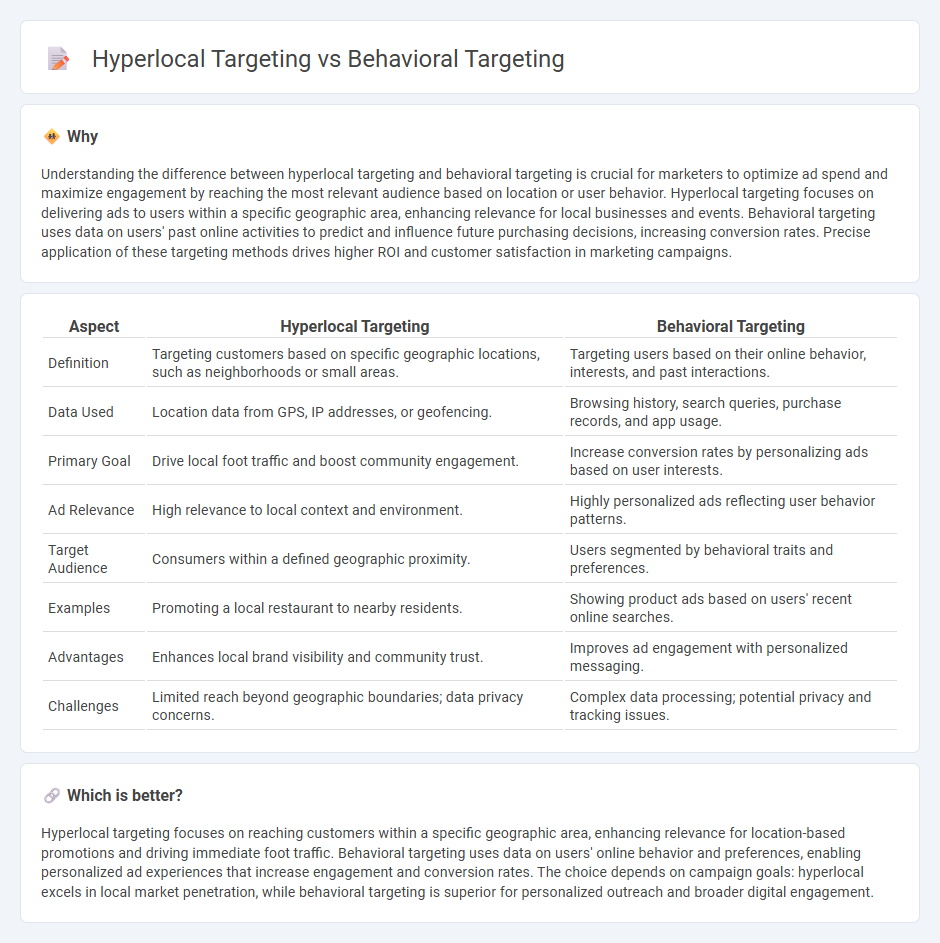
Hyperlocal targeting focuses on reaching customers within a specific geographic area using precise location data, while behavioral targeting uses online behavior, such as browsing history and purchase patterns, to deliver personalized ads. Both methods enhance marketing efficiency by improving relevance and engagement rates. Explore deeper insights on how these strategies can transform your marketing campaigns.
Why it is important
Understanding the difference between hyperlocal targeting and behavioral targeting is crucial for marketers to optimize ad spend and maximize engagement by reaching the most relevant audience based on location or user behavior. Hyperlocal targeting focuses on delivering ads to users within a specific geographic area, enhancing relevance for local businesses and events. Behavioral targeting uses data on users' past online activities to predict and influence future purchasing decisions, increasing conversion rates. Precise application of these targeting methods drives higher ROI and customer satisfaction in marketing campaigns.
Comparison Table
| Aspect | Hyperlocal Targeting | Behavioral Targeting |
|---|---|---|
| Definition | Targeting customers based on specific geographic locations, such as neighborhoods or small areas. | Targeting users based on their online behavior, interests, and past interactions. |
| Data Used | Location data from GPS, IP addresses, or geofencing. | Browsing history, search queries, purchase records, and app usage. |
| Primary Goal | Drive local foot traffic and boost community engagement. | Increase conversion rates by personalizing ads based on user interests. |
| Ad Relevance | High relevance to local context and environment. | Highly personalized ads reflecting user behavior patterns. |
| Target Audience | Consumers within a defined geographic proximity. | Users segmented by behavioral traits and preferences. |
| Examples | Promoting a local restaurant to nearby residents. | Showing product ads based on users' recent online searches. |
| Advantages | Enhances local brand visibility and community trust. | Improves ad engagement with personalized messaging. |
| Challenges | Limited reach beyond geographic boundaries; data privacy concerns. | Complex data processing; potential privacy and tracking issues. |
Which is better?
Hyperlocal targeting focuses on reaching customers within a specific geographic area, enhancing relevance for location-based promotions and driving immediate foot traffic. Behavioral targeting uses data on users' online behavior and preferences, enabling personalized ad experiences that increase engagement and conversion rates. The choice depends on campaign goals: hyperlocal excels in local market penetration, while behavioral targeting is superior for personalized outreach and broader digital engagement.
Connection
Hyperlocal targeting and behavioral targeting are interconnected by their focus on delivering personalized marketing messages based on specific consumer data. Hyperlocal targeting uses geographic information to target audiences within a narrowly defined area, while behavioral targeting analyzes users' online behavior and preferences to tailor content. Combining these strategies enhances marketing effectiveness by delivering highly relevant ads that consider both location and individual behavior patterns.
Key Terms
User Behavior Data
Behavioral targeting uses user behavior data such as browsing history, purchase patterns, and online interactions to deliver personalized ads that match individual interests and preferences. Hyperlocal targeting leverages geographic data to target users in specific locations, focusing on physical proximity rather than behavior. Explore the differences and advantages of these targeting strategies to enhance your marketing effectiveness.
Geographic Location
Behavioral targeting uses user data such as browsing history, interests, and online behavior to deliver personalized ads, while hyperlocal targeting focuses specifically on geographic location to reach audiences within a precise area like a neighborhood or city block. Hyperlocal targeting leverages GPS data, Wi-Fi signals, and IP addresses to create location-specific campaigns, which are highly effective for local businesses aiming to attract customers nearby. Explore how integrating both strategies can maximize advertising efficiency and drive targeted engagement.
Personalization
Behavioral targeting leverages user data such as browsing history, purchase behavior, and online interactions to deliver personalized advertisements tailored to individual preferences. Hyperlocal targeting focuses on geographic location data, offering highly relevant ads based on a consumer's immediate surroundings, enhancing local engagement. Explore how integrating these strategies can maximize personalization and improve campaign effectiveness.
Source and External Links
What is Behavioral Targeting? | Examples, Benefits & How It Works - Behavioral targeting is a digital advertising strategy that analyzes users' online activities--such as browsing history, purchase patterns, and content engagement--to group them into segments and deliver more relevant ads.
What Is Behavioral Targeting? How It Works (in 4 Steps) - Behavioral targeting collects data on users' web behavior, segments audiences by shared interests and actions, and uses these insights to create personalized ad campaigns that match individual user profiles.
What is behavioral targeting and why it's important - Behavioral targeting tracks and analyzes user behavior across online platforms to deliver personalized content and ads, improving campaign relevance, performance, and customer relationships.
 dowidth.com
dowidth.com